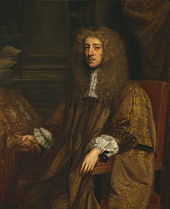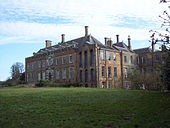- Earl of Shaftesbury
-
Earldom of Shaftesbury 
Creation date 23 April 1672
(339 years, 212 days)Created by Charles II of England Peerage Peerage of England First holder Anthony Ashley-Cooper,
1st Earl of ShaftesburyPresent holder Nicholas Ashley-Cooper,
12th Earl of ShaftesburyHeir apparent Anthony Ashley-Cooper,
Lord AshleyRemainder to heirs male of the body of the grantee Subsidiary titles Baron Ashley
Baron CooperEarl of Shaftesbury is a title in the Peerage of England. It was created in 1672 for Anthony Ashley-Cooper, 1st Baron Ashley, a prominent politician in the Cabal then dominating the policies of King Charles II. He had already in 1631 succeeded his father as second Baronet of Rockbourne and been created Baron Ashley, of Wimborne St Giles in the County of Dorset, in 1661, and was made Baron Cooper, of Paulett in the County of Somerset, at the same time he was given the earldom. These titles are also in the Peerage of England. Baron Ashley is used as a courtesy title by the Earl's eldest son and heir apparent. The Baronetcy, of Rockbourne in the County of Southampton, was created in the Baronetage of England in 1622 for the Earl's father John Cooper. He sat as Member of Parliament for Poole.[1]
Contents
Succession to the earldom
The first Earl was succeeded by his son, Anthony Ashley-Cooper, 2nd Earl of Shaftesbury. He represented Melcombe Regis and Weymouth in the House of Commons. His son, Anthony Ashley-Cooper, succeeded as the 3rd Earl of Shaftesbury upon his death. The 3rd Earl sat as a Member of Parliament but is chiefly remembered as a writer and philosopher. On his death, the titles passed to his son, Anthony Ashley-Cooper, who became the 4th Earl of Shaftesbury. The 4th Earl notably served as Lord Lieutenant of Dorset and Councillor of the Colony of Georgia. He died in 1711, at which time, his son inherited the title of 5th Earl.
Anthony Ashley-Cooper, 5th Earl of Shaftesbury was educated at Winchester and served as Deputy Lieutenant of Dorset. Cropley Ashley-Cooper, younger brother of the 5th Earl, inherited the title of 6th Earl upon the death of his older brother in 1811. The 6th Earl, represented Dorchester in Parliament. He served as member of the Privy Council and Deputy Speaker of the House of Lords. Upon his death, the title was passed to his son. The 7th Earl was a prominent politician, social reformer and philanthropist. He was known as the reforming Lord Shaftesbury in the 19th century, who fought for the abolition of slavery. His eldest son, the 8th Earl, sat as Member of Parliament for Hull and Cricklade. He was succeeded by his son, the 9th Earl, who was the Lord Mayor of Belfast, Lord Lieutenant of Belfast, County Antrim and Dorset and Lord Steward of the Household. On his death, the titles passed to his grandson, the 10th Earl, the son of Anthony Ashley-Cooper, Lord Ashley.
In 2004, Anthony Ashley-Cooper, 10th Earl of Shaftesbury was murdered by his third wife, Jamila M'Barek, and her brother. They were convicted of the crime in 2007, two years after the 10th Earl's body was found dismembered in the French Alps. As of 2010[update] the titles are held by Nicholas Ashley-Cooper, who inherited the titles after his older brother, Anthony Ashley Cooper, 11th Earl of Shaftesbury died in May 2005. The 11th Earl died of a heart attack in New York City, while visiting his younger brother on holiday.
Other prominent members of the Ashley-Cooper family include Liberal politician Evelyn Ashley, second son of the 7th Earl; his son, noted politician, Wilfrid Ashley, 1st Baron Mount Temple, who was a member of the Conservative Party, and his daughter, Edwina, who married Louis Mountbatten, 1st Earl Mountbatten of Burma, and last Vicereine of India.
It is through the marriage of Edwina to the Earl of Mountbatten that the Earls of Shaftesbury became closely aligned with members of the royal family. Edwina Mountbatten was a leading member of London society. Edwina's mother was Amalia Mary Maud Cassel (1879–1911), daughter of the international magnate Sir Ernest Cassel, who was a friend and private financier to the future King Edward VII. Cassel was one of the richest and most powerful men in Europe.
When her grandfather died in 1921, Edwina inherited his vast fortune, which included £2 million, the 5,000 acres (20 km2) country seat of Broadlands, Romsey, co. Hampshire; Brooke House in London; Moulton Paddocks estate in Newmarket, Suffolk; and the seaside home at Branksome Dene in Bournemouth, Dorset. She also inherited Classiebawn Castle, Mullaghmore, County of Sligo, Ireland. Ashley and Mountbatten were married on 18 July 1922 at St Margaret's, Westminster. The Royal family were all present and the then-Prince of Wales (the future King Edward VIII) served as best man. The relationship between the two families continues today, as descendants of the Ashley-Cooper line have often been named godchildren of various members of the royal family.
It was at the country seat of Broadlands that Queen Elizabeth II and her husband Prince Phillip, spent their honeymoon night in 1947. In turn, Prince Charles and his first wife, Princess Diana, spent their honeymoon night there in 1981.
St Giles House
The family seat is St Giles House, (sometimes referred to as Ashley House) near Wimborne St Giles in Dorset. The estate at Wimborne St Giles came into the ownership of the Ashley family around the year 1460, through the marriage of Egidia Hamelyn and Robert Ashley, the 5th great grandfather of the 1st Earl of Shaftesbury.
Early owners of the estate included the Malmayne family. Matilda Malmayne, heiress of the estate, married Edmund Plecy. The Plecy male line became extinct towards the end of the fourteenth century, and the estate was transferred to Edmund and Matilda's descendant Joan Plecy, as heiress. Lady Joan Plecy was soon married to Sir John Hamelyn (d. 1399), but with no male heirs, the estate went to Sir John's daughter Egidia, by his second wife, who married Robert Ashley. The estate has belonged to the Ashleys and Ashley-Coopers ever since.
Construction on St Giles House began in 1651, by Sir Anthony Ashley-Cooper, later to become 1st Earl of Shaftesbury. The manor house is built on top of the ruins of the previous estate home. This large house and surrounding grounds include 400 acres (1.6 km2), along with a seven-acre lake and a 1,000 yards (900 m) avenue of trees. The family also owns Lough Neagh, the largest lake in the British Isles.
As noted by Christopher Hussey in his article on St Giles' House,[2] "The whole, so little changed in two centuries, is a splendid example of the Kent manner changing into the rococo of the mid-century." However, following World War II, the contents of these rooms have been gradually dispersed in a number of sales. The record of these and a number of published articles indicate that the design of the furniture shows a highly accomplished progression from the architectural Palladian style to the full fanciful rococo style. The accomplished design, together with the high level of craftsmanship, clearly indicate a metropolitan origin for the majority of these pieces, but unfortunately the surviving Shaftesbury Account Books contain few references to London cabinet-makers other than William Hallett, his name appearing a number of times between 1745 and 1757 with references to 'carved chairs,' 'the Blew Bed,' and 'Mahogany Cisterns.' The payments to other cabinet-makers mentioned in accounts are small in nature and probably indicate their local origins. [3]
The Shaftesburys are known to have had connections with London cabinet makers. The 4th Earl's wife, Lady Susannah Noel, daughter of Baptist Noel, 3rd Earl of Gainsborough, was one of the 26 aristocratic subscribers to the first edition of Thomas Chippendale's Director (1754). His second wife, Lady Mary Bouverie, was the daughter of the 1st Viscount Folkestone who was a major patron of William Hallett and Benjamin Goodison, her brother the 2nd Viscount acquiring pieces from the Royal cabinetmakers William Vile and John Cobb. [4]
South Carolina
The Ashley and Cooper Rivers in South Carolina were named for the 1st Earl of Shaftesbury, who was the Chief Lord Proprietor of the Carolina Colony. Charleston was founded on the western bank of the Ashley in 1670 (at Charles Towne Landing), before moving across to its current peninsular location ten years later.[5]
Cooper Baronets, of Rockbourne (1622)
- Sir John Cooper, 1st Baronet (died 1631)
- Sir Anthony Ashley-Cooper, 2nd Baronet (1621–1683) (created Baron Ashley in 1661, and Earl of Shaftesbury in 1672)
Earls of Shaftesbury (1672)
- Anthony Ashley-Cooper, 1st Earl of Shaftesbury (1621–1683)
- Anthony Ashley-Cooper, 2nd Earl of Shaftesbury (1652–1699)
- Anthony Ashley-Cooper, 3rd Earl of Shaftesbury (1671–1713)
- Anthony Ashley-Cooper, 4th Earl of Shaftesbury (1711–1771)
- Anthony Ashley-Cooper, 5th Earl of Shaftesbury (1761–1811)
- Cropley Ashley-Cooper, 6th Earl of Shaftesbury (1768–1851)
- Anthony Ashley-Cooper, 7th Earl of Shaftesbury (1801–1885)
- Anthony Ashley-Cooper, 8th Earl of Shaftesbury (1831–1886)
- Anthony Ashley-Cooper, 9th Earl of Shaftesbury (1869–1961)
- Anthony Ashley-Cooper, Lord Ashley (1900-1947)
- Anthony Ashley-Cooper, 10th Earl of Shaftesbury (1938–2004)
- Anthony Nils Christian Ashley-Cooper, 11th Earl of Shaftesbury (1977–2005)
- Nicholas Edmund Anthony Ashley-Cooper, 12th Earl of Shaftesbury (born 1979)
The heir apparent is the present holder's son, Anthony Francis Wolfgang Ashley-Cooper, Lord Ashley (born 2011).[6]
References
- ^ Doyle, James William Edmund. The Official Baronage of England: Pembroke-Zetland, London: Longman, Green, & Company, 1886, Vol. II, Pg. 300
- ^ Hussey, Christopher. Country Life, "St. Giles's House, Dorset," September 10, 17, 24, 1943)
- ^ Sotheby's Lot No. 93
- ^ Doyle, James William Edmund. The Official Baronage of England: Pembroke-Zetland, London: Longman, Green, & Company, 1886, Vol. II, Pg. 300
- ^ Historic Charleston Foundation
- ^ "Announcements" (in English). The Times (London, UK: The Times). 27 January 2011. Full text: "ASHLEY-COOPER, On 24th January 2011 to the Earl and Countess of Shaftesbury (née Streifeneder) a beautiful son, Anthony Francis Wolfgang."
Further reading
- Kidd, Charles & Williamson, David (editors). Debrett's Peerage and Baronetage (1990 edition). New York: St Martin's Press, 1990.
- Leigh Rayment's Peerage Pages
Categories:- Earldoms
- Ashley-Cooper family
Wikimedia Foundation. 2010.


